Hobbyaana
Love Birds Types, Care, Information Finding Forever 'Love Birds' and Their Endearing Symbolism in English PART 1
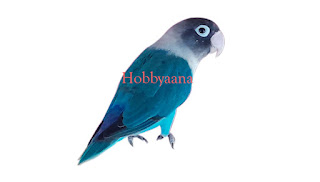 |
| Musk love bird |
Introduction
When it comes to love and companionship in the avian world, few creatures capture our imagination as much as the enchanting "Love Birds." These small, colorful parrots have earned their name not only for their striking appearance but also for their endearing behavior that mirrors the most cherished aspects of human relationships. In this blog, we'll explore the origins of the term "Love Birds" and delve into the captivating symbolism they hold.
इस लेख को हिंदी में पड़ने के लिए इसपर CLICK करे
এই লেখাটি বাংলায় পড়ার জন্য এখানে CLICK করুনThe Origin of the Name
The term "Love Birds" is believed to have originated from the way these birds interact with one another. Native to the African continent, these parrots are often seen sitting closely together, preening each other's feathers, and engaging in gentle beak-to-beak interactions. These affectionate displays of bonding led observers to draw parallels between the birds' behaviors and the intimacy shared between romantic partners, coining the term "Love Birds."
If you read the part 2 please CLICK here
Symbolism of Love Birds
Affection and Companionship: Love Birds are renowned for their strong monogamous bonds. Once they find a partner, they often stay together for life. This unwavering commitment symbolizes the depth of connection and devotion that many seek in their own relationships.
Communication: Love Birds have a unique way of communicating with each other, using soft chirps, preening, and physical closeness. Their ability to understand and respond to each other's cues showcases the importance of effective communication in any partnership.
Vibrant Colors: Love Birds come in a variety of vibrant and captivating colors. These colors can be likened to the spectrum of emotions experienced in love, from the fiery passion of red to the serene calmness of blue.
Resilience: These small birds are known for their resilience in the face of challenges. Just like any relationship, they may encounter difficulties, but their ability to adapt and thrive together reflects the strength needed to overcome obstacles in love.
Cultural References
The symbolism of Love Birds extends beyond the realm of ornithology. These birds have appeared in various cultures and art forms as representations of love and partnership:
Art and Literature: Love Birds have been depicted in paintings, poetry, and literature as symbols of romance and unity. Their image has been immortalized in countless artistic creations, emphasizing their timeless association with love.
Wedding Symbolism: Love Birds are often incorporated into wedding themes, decorations, and invitations, representing the union of two souls in matrimony and the promise of lifelong companionship.
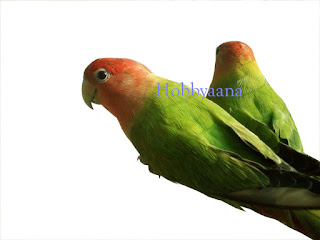
Opline love bird
A Kaleidoscope of Lovebird Species: Exploring Origins and Characteristics
Introduction: Lovebirds, those vibrant and charming avian companions, have captured the hearts of bird enthusiasts around the world with their captivating personalities and colorful plumage. These small parrots belong to the genus Agapornis and come in a delightful array of species and mutations. In this blog, we embark on a journey to discover the fascinating diversity of lovebird types, each with its unique characteristics and traits.
Origins of Lovebirds: A Global Journey
Native to the African continent, lovebirds are primarily found in arid and savannah regions. They belong to the genus Agapornis, which is derived from the Greek words "agape" meaning love, and "ornis" meaning bird. This aptly reflects their reputation as affectionate and devoted companions.
1. Peach-Faced Lovebirds (Agapornis roseicollis): Peach-faced lovebirds are perhaps the most well-known and beloved of all lovebird species. Recognizable by their vibrant green bodies and distinctive peach-colored face patches, these sociable birds are often hailed for their playful and affectionate behavior. They come in various color mutations, including lutino, albino, and pied variations. Peach-faced lovebirds are known for their strong bonding tendencies with their mates, making them popular pets.
Peach-faced Lovebirds (Agapornis roseicollis): Originating from southwestern Africa, these lovebirds are known for their distinct peach-colored face and vibrant plumage. Their playful nature and ability to mimic sounds make them popular among pet owners. They are one of the most widespread and readily available species in aviculture.
2. Fischer's Lovebirds (Agapornis fischeri): Named after the German explorer Gustav Fischer, these lovebirds feature a striking combination of green plumage and a bright red face. Fischer's lovebirds are known for their curious and active nature, often engaging in acrobatics and playful behaviors. They have a reputation for being a bit more independent compared to other lovebird species, making them suitable for bird owners who want a balance between interaction and independence.
Fischer's Lovebirds (Agapornis fischeri): Indigenous to the eastern and central parts of Africa, Fischer's lovebirds are known for their bright red beaks and eye-catching coloring. They possess a charming personality, forming strong bonds with their human caregivers. Their captivating appearance and endearing antics have made them a favorite among bird enthusiasts.
3. Masked Lovebirds (Agapornis personatus): Masked lovebirds display a more muted color palette compared to some of their counterparts. They have a green body with a dark-colored "mask" covering their face, which gives them their name. Masked lovebirds are known for their gentle and calm demeanor, making them a wonderful choice for those looking for a more serene avian companion. They thrive on regular social interaction and can form strong bonds with their human caregivers.
Masked Lovebirds (Agapornis personatus): Hailing from the central regions of Africa, masked lovebirds are named after the distinctive black "mask" pattern on their faces. They are characterized by their green bodies and varying colors of facial masks. Their energetic and social behavior makes them a delight to observe and interact with.
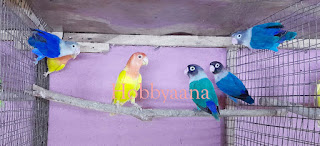 |
| love birds |
4. Black-Cheeked Lovebirds (Agapornis nigrigenis): Black-cheeked lovebirds stand out with their predominantly green plumage and distinct black markings on their cheeks. These birds are known for their vocal nature, often emitting a range of chirps, whistles, and squawks. While they are social creatures, they may exhibit some territorial behavior, making proper socialization and cage setup important for their well-being.
Black-cheeked Lovebirds (Agapornis nigrigenis): Found in the highlands of Zambia, these lovebirds showcase a striking contrast between their emerald green bodies and the black markings on their cheeks and throats. Their melodious vocalizations and friendly temperament have made them popular pets for bird enthusiasts seeking a delightful feathered companion.
5. Nyasa Lovebirds (Agapornis lilianae): Hailing from the African continent, Nyasa lovebirds are characterized by their deep green coloration and a unique red-orange face. These lovebirds are a bit less common in the pet trade but are cherished by those who appreciate their beauty and charm. Nyasa lovebirds are known for their gentle and calm personalities, making them great companions for bird enthusiasts seeking a more relaxed and serene interaction.
Nyasa Lovebirds (Agapornis lilianae): Originating from southeastern Africa, Nyasa lovebirds are distinguished by their deep green plumage and a vibrant yellow face. Their inquisitive and social demeanor makes them a joy to interact with. They thrive on companionship and are often kept in pairs to ensure their well-being.
Lilian's Lovebirds (Agapornis lilianae): Discovered in the southwestern regions of Africa, Lilian's lovebirds are the smallest species within the Agapornis genus. They exhibit stunning turquoise plumage with splashes of yellow on their heads and wings. Despite their size, they are known for their bold personalities and lively nature.
6. Abyssinian Lovebirds (Agapornis taranta): Abyssinian lovebirds, also known as black-winged or grey-headed lovebirds, showcase an intriguing blend of green and gray feathers. What sets them apart is the distinct V-shaped pattern on their wings. These lovebirds are known for their relatively reserved behavior and are often regarded as a more independent species within the lovebird family. They may require a bit more patience to establish trust but can form strong bonds with dedicated caregivers.
The world of lovebirds is a diverse and captivating one, filled with a myriad of species and mutations that cater to different preferences and personalities. Whether you're drawn to the vibrant and playful nature of Peach-faced lovebirds or the serene companionship of Masked lovebirds, there's a lovebird type that's sure to steal your heart. As with any pet, providing proper care, attention, and socialization is key to nurturing a happy and fulfilling relationship with these enchanting avian companions.
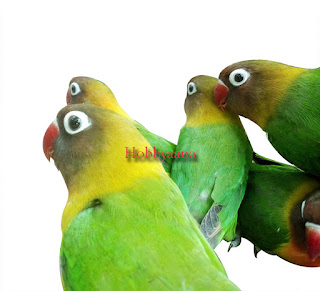 |
| Fischer's Lovebirds |
Nurturing Love Birds: A Comprehensive Guide to Their Diet and Health
Lovebirds, with their vibrant colors and affectionate nature, have been cherished as beloved pets for years. To ensure the well-being and happiness of these charming companions, it's crucial to provide them with the right diet and proper healthcare. In this guide, we'll delve into the world of lovebird nutrition, explore their dietary needs, and discuss essential medicines for their optimal health.
Part 1: The Perfect Diet for Lovebirds
Lovebirds have specific dietary requirements that mirror their wild diet. Balancing their intake of seeds, fruits, vegetables, and supplements is vital for their overall health.
Seed Mix: A high-quality seed mix serves as a foundational element of a lovebird's diet. Look for mixes that include a variety of seeds such as millet, canary grass seeds, and safflower seeds. However, avoid seed-only diets, as they lack essential nutrients.
Pellets: Pelleted diets designed for lovebirds offer a more balanced and controlled nutrition source. These pellets are enriched with vitamins, minerals, and amino acids, ensuring your bird gets a well-rounded diet. Introduce pellets gradually to allow your lovebirds to adapt.
Fresh Vegetables: Leafy greens like kale, spinach, and Swiss chard provide essential vitamins and minerals. Other vegetables such as carrots, bell peppers, and broccoli offer variety and texture to their diet.
Fruits: Fruits like apples, berries, melons, and oranges add natural sugars and antioxidants to their diet. Remember to remove any seeds or pits that could be toxic.
Proteins: Offer protein sources like boiled eggs and legumes in moderation. These are particularly important during breeding season and molting.
Grit and Minerals: Provide grit (small, insoluble stones) to help with digestion, and a cuttlebone or mineral block for calcium supplementation and beak conditioning.
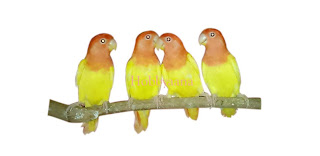
Lutino opline love birds
Part 2: Medicines and Healthcare
Ensuring the health of your lovebirds involves being aware of common health issues and having a basic understanding of medicines and treatments.
Avian Veterinarian: Regular visits to an avian veterinarian are crucial. They can perform wellness checks, offer advice on diet and habitat, and address any health concerns.
Common Health Issues: Be watchful for signs of illness such as lethargy, changes in appetite, feather plucking, or unusual droppings. Common ailments include respiratory infections, mites, and nutritional deficiencies.
Medicines: Always consult a veterinarian before administering any medications. Some commonly prescribed medications include antibiotics for infections, antiparasitic treatments for mites or worms, and probiotics to maintain gut health.
First Aid Kit: Keep a basic first aid kit ready, including items like styptic powder for minor bleeding, cotton swabs, and antiseptic wipes.
Quarantine: Introduce new birds to your existing flock only after a quarantine period. This helps prevent the spread of diseases.
Stress Reduction: Lovebirds are sensitive creatures; keep their environment stress-free to promote good health. Adequate sleep, mental stimulation, and social interaction are key.
Part 3: Lovebird Enrichment
Healthy lovebirds are not just about diet and medicines; mental stimulation and physical exercise are equally essential.
Toys and Perches: Provide a variety of toys like ropes, bells, and puzzle toys to keep your lovebirds engaged. Different perches of varying diameters help exercise their feet.
Flight Time: Allow supervised flight time outside the cage in a safe and enclosed area. This provides exercise and mental stimulation.
Social Interaction: Lovebirds are social creatures; pair them or spend time interacting with them daily. Loneliness can lead to stress and health issues.
In conclusion, providing a well-rounded diet, proper healthcare, and ample enrichment are the pillars of maintaining the health and happiness of lovebirds. By understanding their unique needs and fostering a supportive environment, you can create a wonderful life for these charming companions. Remember, a healthy lovebird is a joyful lovebird!
The Charm of Lovebirds: Endearing Personalities and Social Bonds
Lovebirds are known not only for their stunning appearances but also for their remarkable personalities. These small parrots possess strong social instincts, often forming deep bonds with their partners and human caregivers. Their playful behavior, coupled with their ability to mimic sounds and even words, adds to their appeal as engaging companions.
In their natural habitat, lovebirds are often seen in pairs, engaging in mutual preening and affectionate behaviors. When kept as pets, they seek companionship and thrive when given ample opportunities for social interaction. Their affectionate nature has earned them the reputation of being "lovebirds," symbolizing the love and devotion they bring to those who care for them.
In conclusion, lovebirds represent a diverse and enchanting group of avian species, each with its own unique characteristics and origins. Whether you're drawn to the striking colors of the Peach-faced Lovebirds, the masked allure of the Masked Lovebirds, or the captivating charm of Fischer's Lovebirds, these avian companions have a special place in the hearts of bird enthusiasts worldwide. Their origins in the African continent and their engaging personalities make them a wonderful addition to both aviculture and the world of pet companionship.
 |
| musk Lovebirds |
If you read another article please click this - Tuberose Adenium Bougainvillea Budgie parrot Chrysanthemum
THANK YOU




No comments:
Post a Comment